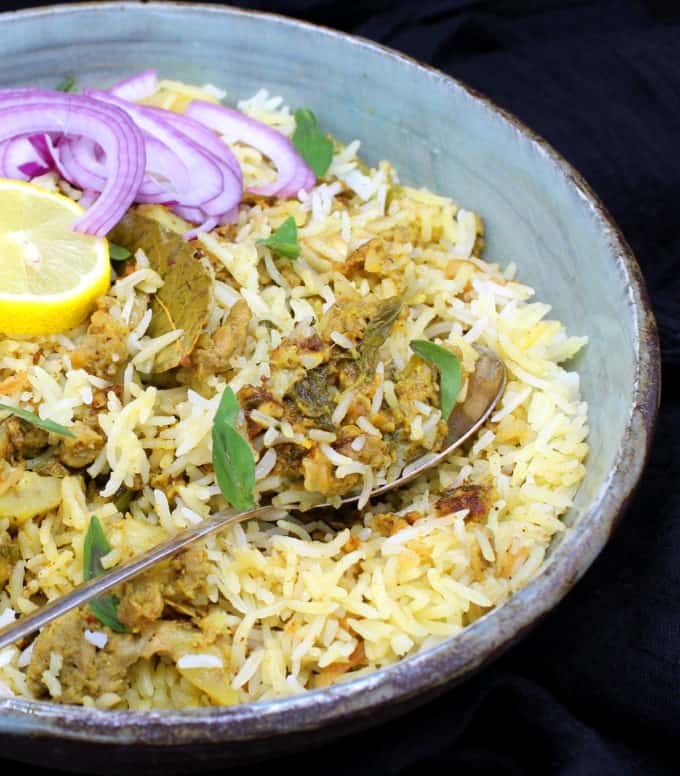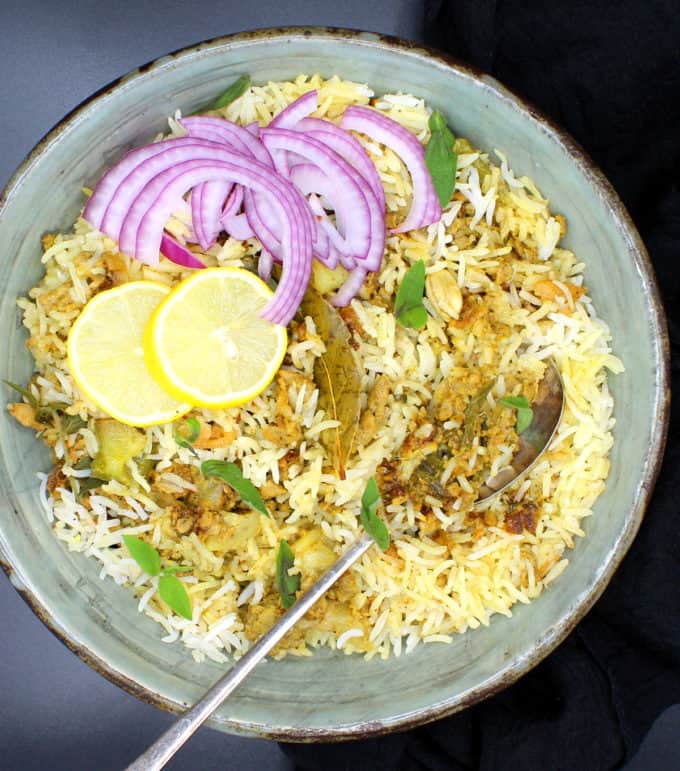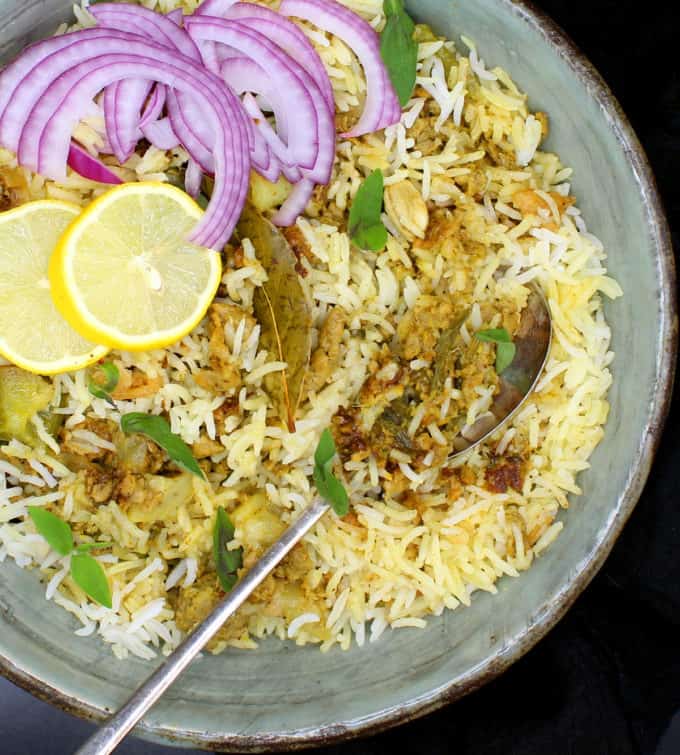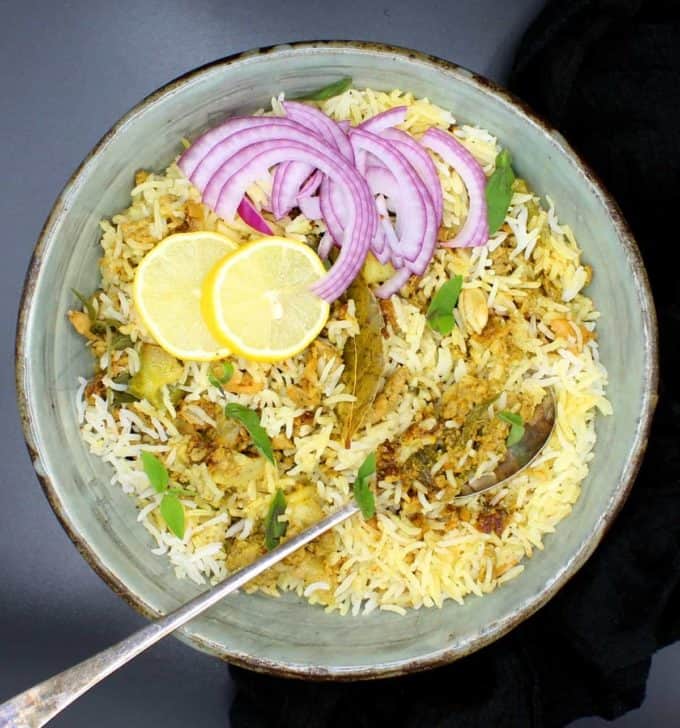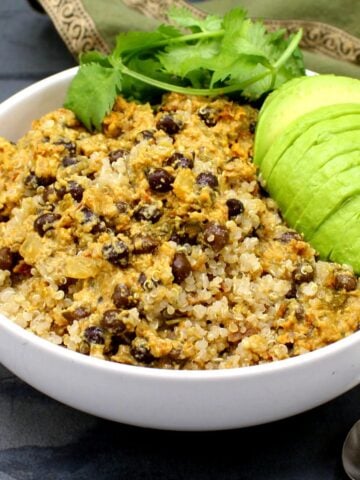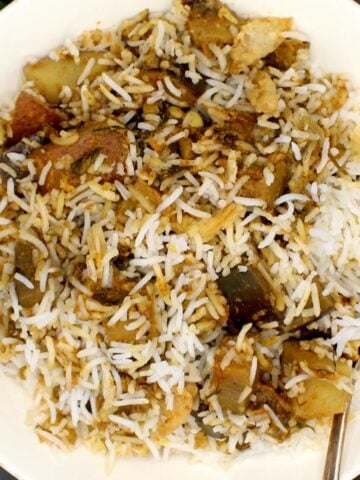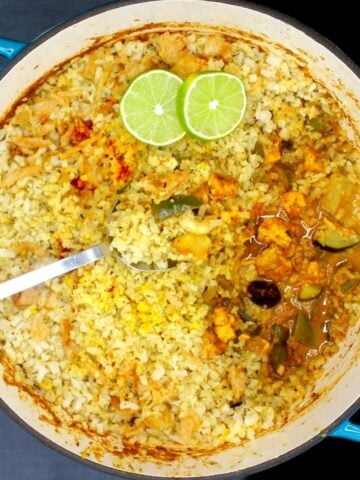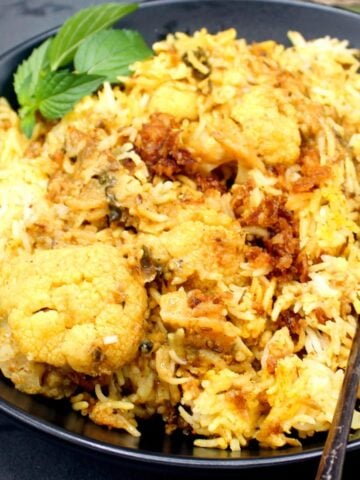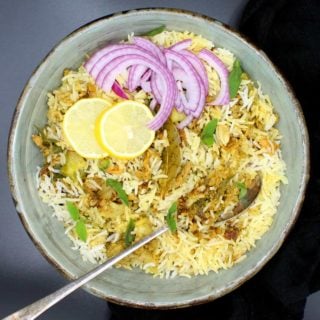I don’t just love a good vegetable biryani–I often simply crave it. That’s why I’ve shared so many versions of biryani with you on the blog, including vegan kofta biryani and dum aloo biryani. Now add to that list this a sumptuous, appetizing Vegan Keema Biryani. Most of us vegans were either once carnivores themselves, or we live with someone who is. As someone who belongs to both groups, I love it when I come up with a great recipe that tastes like the real thing and satisfies everyone’s tastebuds, without the animal stuff. This Keema Biryani certainly checks all those boxes. If you love a hearty rice dish, this is a great variation on the biryani you might already be familiar with, which uses whole meats (or tofu or vegetables, if you’re vegan). Only, this version is even better. If you have an omnivore in your life, or are even just trying to eat more plant-based meals, give it a try.
What you’ll love about this recipe:
It’s an authentic, no-compromises biryani, the kind you’d eat at an Indian restaurant—in Hyderabad. It’s super easy to make, in fact, it’s fool-proof, even if you’re new to cooking (so long as you follow instructions). It’s hearty comfort food for vegans and non-vegans alike. It smells so great as it cooks, you’ll literally be salivating. If you have kids, they’ll love it. Did I say it’s delicious?
Common myths about making a biryani
It’s time-consuming: This is one myth that absolutely needs to be turned on its head because making a biryani is not just not time-consuming, it is one of my go-to dishes when I need a quick, tasty, healthy dinner. This recipe should take you no more than 45 minutes to make, and, if you pace yourself, you can make it even faster. It’s difficult: Another myth that deserves to be busted, because making a biryani is rather easy. If you follow instructions, it’s even fool-proof. You make the rice, then the biryani masala, put it all together, and you’re done. Following that thought, the rice and the masala need to cook in two distinct layers in your pot, if you want a biryani that tastes like it should. Cooks unfamiliar with Indian cooking will often mix everything up in the pot, but that’s not a biryani–that’s a pulao. When you serve up a biryani, you should dig your ladle all the way to the bottom so you get both the masala and the rice, but in two separate layers. Pulaos and biryanis are two distinct rice dishes, and while I am not one for strict rules in the kitchen, calling a pulao a biryani is like calling a blueberry cake a blueberry pie. They have much of the same ingredients, but they really aren’t the same dish. See?
How to make biryani rice
Start with a good basmati rice. When it comes to biryanis, no other rice will do. Soak the rice for at least a half hour before cooking, and wash it thoroughly in running water. This is best done in a colander. What this does is gets rid of the excess starch and the grains of rice in your final biryani will be long and separate, exactly the way they should be. Another way to ensure the rice grains are long and separate is to not overcook them. Follow my instructions closely—if you microwave the rice, use 2 ½ cups of water to cook 2 cups of the soaked, drained rice along with salt and spices for exactly eight minutes. If you do this on the stovetop, cook the rice as you would pasta. Bring a big pot of water to boil along with the spices and salt, and cook the rice to about 80 percent doneness. The rice grains should be soft on the outside but should still feel a bit raw and firm when you bite into them. Undercooking the rice is important because the grains will continue to cook with the rest of the biryani ingredients. If you overcook the rice, your rice will probably turn to mush as you serve it. It won’t ruin your dish, but your presentation won’t be as nice.
Which meatless meat should I use for the “keema”?
In India, since the politically motivated ban on beef, keema usually refers to ground goat or chicken meat, and most recipes cooked there would use one of these two types of meat. Vegan meat substitutes work nicely in keema recipes (my must-try’s– vegan keema masala and vegan Indian curry with keema). Check to get new recipe updates by email.
I’ve tried this keema biryani recipe with different plant-based meats to get an authentic flavor, and the winner, for me, is Beyond Beef. It has the right flavor to substitute for the actual meat, but more importantly, it tends to be fattier than other meat substitutes, so the biryani remains moist and luscious. That said, you can use another ground meat substitute with good results.
More ingredients for making the perfect biryani
Use a biryani masala (I’ll add an affiliate link in the recipe box, or you can find it at an Indian grocery store). You can buy biryani masalas in a jar, but I like the powdered kind, which is usually sold in a flat carton. You can also just try making my biryani masala at home. Add a dash of garam masala. I know most of you who love cooking Indian food have some at home. Put it to good use here. You also will add a few whole spices here, including green and brown cardamom, cloves, and dry bay leaves. You will need vegan yogurt. You can definitely use my homemade cultured cashew yogurt, which so many of you love. Or, if you’re nut-free or would rather not go to the trouble, use storebought vegan yogurt of any kind, so long as it’s not sweetened. Two herbs—cilantro and mint—are absolutely necessary and even indispensable for the authentic biryani flavor. If you don’t have both, you can, at a pinch, do without, but I wouldn’t recommend it. A third herb, a dry one, also goes a long way in making this biryani utterly flavorful—kasoori methi, or dry fenugreek leaves. These are sold at Indian grocery stores, and online. If you keep some on hand, you’ll find lots of Indian recipes to use them in, including vegan butter chicken and vegan dal makhani. Fried onions. The best kind of fried onions to add to your biryani are the ones that you can buy at the store, and by that I mean the ones that are already fried and golden and crispy. You can use the fried onions sold in a plastic packet at the Indian grocer’s, although French’s and other off-the-shelf brands work just as well. If you did this at home, you’d never get the same flavor, and do you really want to stand over a hot pot of boiling oil, frying onions? Ginger and garlic. A biryani not flavored by these should be—and is—unthinkable. Vegetables. My veggies of choice are zucchini and green bell peppers. Both add great flavor and don’t need pre-cooking. Saffron strands, for that final, regal, finishing touch that a biryani, and you, deserve.
Substitution ideas
You really shouldn’t be making biryani with brown rice because as much as I love brown rice, this is a dish that needs the delicate fragrance and flavor of white basmati rice. But if you absolutely will not bend, cook your brown rice first as you would the white rice according to instructions above, on the stovetop. Brown rice will take much longer to get to the right doneness level (and it should be a little more done than the white rice–about 90 percent). Like I said earlier, any meatless meat that crumbles works for this recipe, you could even use vegan sausage pulsed in the food processor to break it down. I like Beyond Beef because it has the right flavor and has more fat which, I understand, is not a great qualification in itself for most people, but it works really well in this biryani. If you want to use different or more vegetables, although don’t overdo it, carrots are a good choice, and potatoes are excellent. If you use potatoes, par-boil them, cube them in large chunks, and then add them to the pot.
What to serve with keema biryani
Cucumber Raita or Kachumber add a fresh, cooling note to the meal. Mirch ka Salan or Bagara Baingan. These are the curries usually served with biryani in the Indian city of Hyderabad, which is famous for this rice dish.
More delicious biryani recipes
Recipe card
